experience third living spaces
experience third living spaces
mind
MIND
2017 / MASTER STUDIES / HAWK x MASTER THESIS / DESIGN FICTION
What about falling in love with technology again?
What about falling in love with technology again?
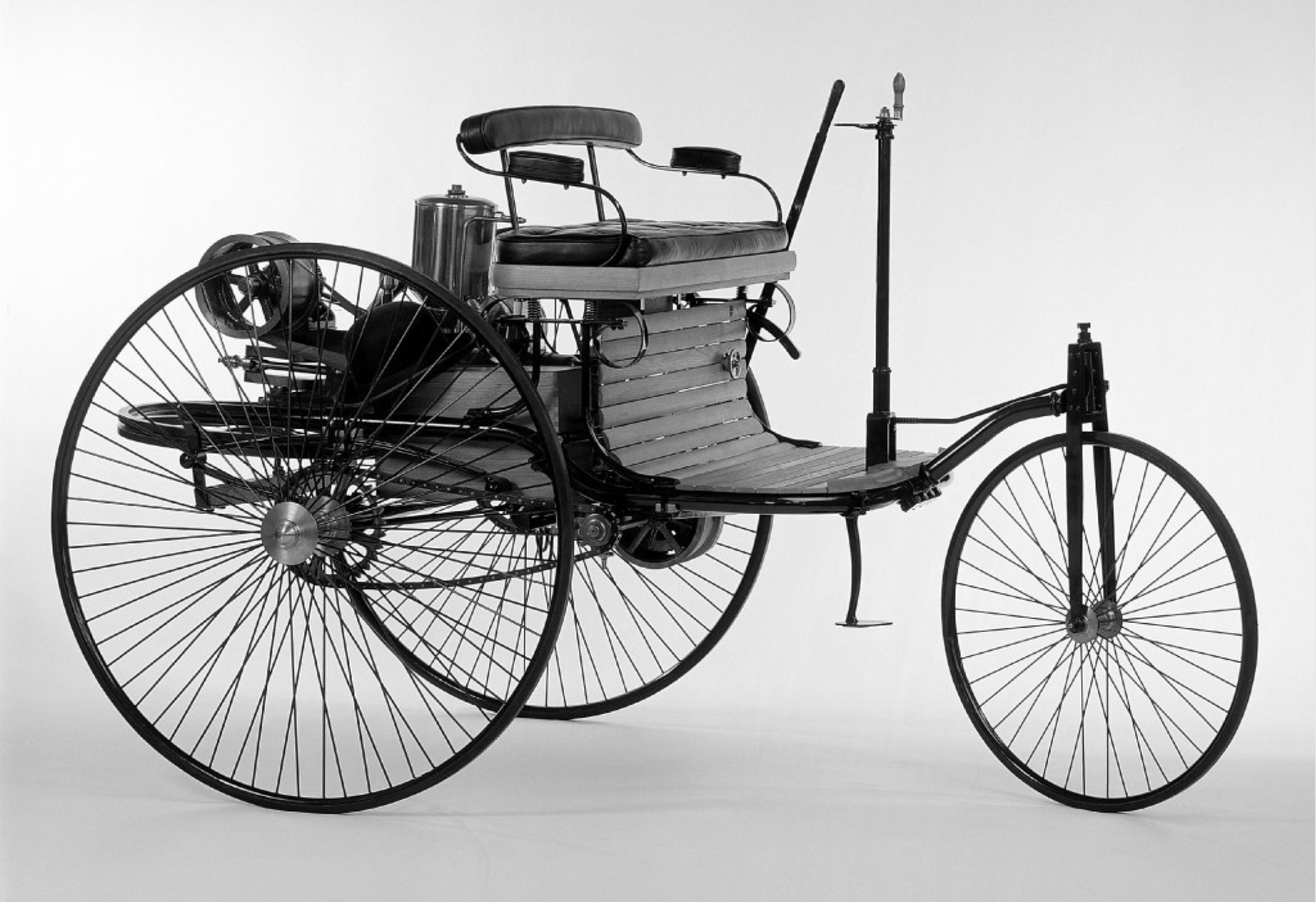

a
a
#What is mind?
#What is mind?
The interface to intelligent and individual mobility
The interface to intelligent and individual mobility
In core, mind is an intelligent interface to a fleet of autonomous vehicles and the main part of a service that organizes vehicles in an individual, needs-based approach for people and can be fully operated by voice. With the help of mind, the user is individually supported in all mobility matters before, during and after a journey. This is possible, because mind gets to know the user better and better over time and remembers his or hers movement profiles, daily routines and preferences from which it can continuously control the mobility needs more intelligently.
While driving in the vehicle, mind creates a third living space tailored to the user, whether he or she wants to work, learn, travel or relax.
In core, mind is an intelligent interface to a fleet of autonomous vehicles and the main part of a service that organizes vehicles in an individual, needs-based approach for people and can be fully operated by voice. With the help of mind, the user is individually supported in all mobility matters before, during and after a journey. This is possible, because mind gets to know the user better and better over time and remembers his or hers movement profiles, daily routines and preferences from which it can continuously control the mobility needs more intelligently.
While driving in the vehicle, mind creates a third living space tailored to the user, whether he or she wants to work, learn, travel or relax.
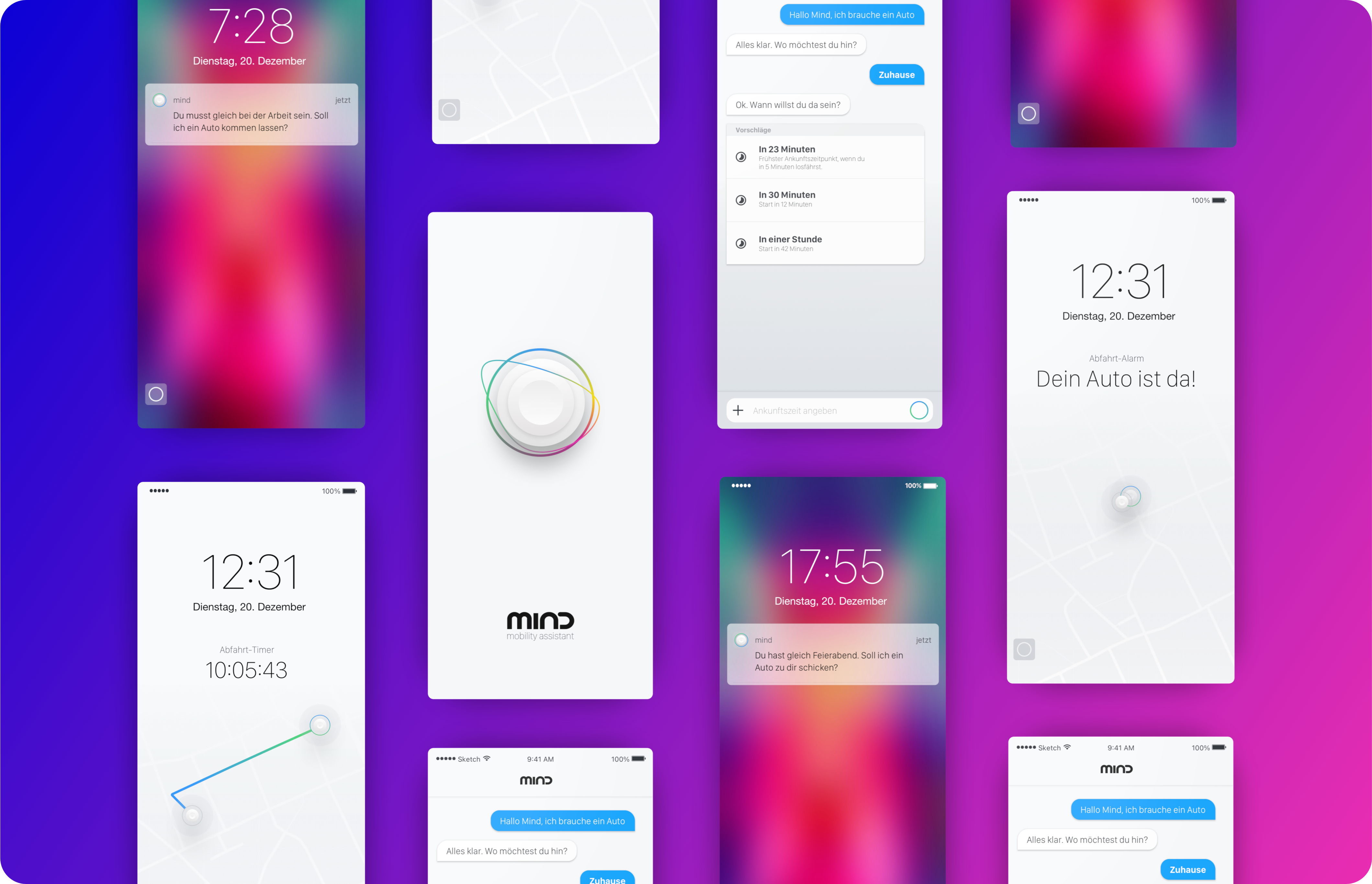
The synergy between sharing economy, autonomous driving and ai will shape new kinds of third living spaces in the future.
The synergy between sharing economy, autonomous driving and ai will shape new kinds of third living spaces in the future.
Key benefits of mind
Key benefits of mind
#01
#01
Perfectly organized mobility and uninterrupted activities
Perfectly organized mobility and uninterrupted activities
A learning neural network provides the user with suitable mobility offers that get him or her to work, home or to appointments on time. Everyday situations and the users mood are taken into account so that adjustments can be made at the micro level. Additionally actions from all areas of human life can be started and continued without interruption during the change of living spaces - especially thanks to the new possibilities of autonomous driving.
A learning neural network provides the user with suitable mobility offers that get him or her to work, home or to appointments on time. Everyday situations and the users mood are taken into account so that adjustments can be made at the micro level. Additionally actions from all areas of human life can be started and continued without interruption during the change of living spaces - especially thanks to the new possibilities of autonomous driving.
#02
#02
Careful companion in everyday life
Careful companion in everyday life
By networking with the users digital ecosystem, mind also reminds him or her of necessary purchases at the supermarket or an upcoming birthday and integrates suggestions and stops into existing routes. But it also learns the users personal interests and can point out places of interest along the way, guide to the perfect restaurant or point out popular activities.
By networking with the users digital ecosystem, mind also reminds him or her of necessary purchases at the supermarket or an upcoming birthday and integrates suggestions and stops into existing routes. But it also learns the users personal interests and can point out places of interest along the way, guide to the perfect restaurant or point out popular activities.
#03
#03
Sustainability through swarm intelligence
Sustainability through swarm intelligence
Instead of many vehicles that capacitive are not or only partially used, high costs due to owning a vehicle and poor use of urban living spaces to the disadvantage of people and environment, a fleet of autonomous, intelligently networked vehicles enables 100% needs-based mobility coverage for all people. In this way, all existing living spaces can be positively relieved in the long term.
Instead of many vehicles that capacitive are not or only partially used, high costs due to owning a vehicle and poor use of urban living spaces to the disadvantage of people and environment, a fleet of autonomous, intelligently networked vehicles enables 100% needs-based mobility coverage for all people. In this way, all existing living spaces can be positively relieved in the long term.
#Research_Desk & literature research, surveys, interviews, shadowing, what if
#Research_Desk & literature research, surveys, interviews, shadowing, what if
Evolution of the personal vehicle
Evolution of the personal vehicle
Carl Benz shaped the year 1886 as the birth of the modern, series-produced automobile. A new era of mobility began, which has triggered massive changes in many areas of life that continue to this day. People were now able to move faster and further. Because of this advantage, more and more space was granted to motorised road traffic over time - cities, professions and services changed around the personal vehicle. Disadvantages, such as environmental pollution or a high number of traffic fatalities each year, do not prevent people from using this innovation.
Since then, the evolution of the vehicle has continued unabatedly. Over time these evolutionary developments of the vehicle were no longer limited exclusively to driving faster and faster, but also increasingly to comfort and features in the vehicle interior and also around mobility services.
Today more than ever the vehicle defines itself as a third living space. It represents a mobile space with personal elements and a strong emotional bond. Nevertheless, it is a fact that these days the scope of action in the vehicle as a Third Living Space is limited by the focus on participation in road traffic and the operation of the vehicle. Autonomous driving, which represents the next evolutionary step of the vehicle will fundamentally change this fact. Once again people and the entire infrastructural ecosystem of the personal vehicle face a new threshold of dramatic change. Once again the disadvantages will be overshadowed by the massive advantages of autonomous driving. Although the promise of autonomous driving is, that connected technologies will promote increased safety and significantly reduced accident rates, because humans themselves remain the greatest risk factor on the roads.
Carl Benz shaped the year 1886 as the birth of the modern, series-produced automobile. A new era of mobility began, which has triggered massive changes in many areas of life that continue to this day. People were now able to move faster and further. Because of this advantage, more and more space was granted to motorised road traffic over time - cities, professions and services changed around the personal vehicle. Disadvantages, such as environmental pollution or a high number of traffic fatalities each year, do not prevent people from using this innovation.
Since then, the evolution of the vehicle has continued unabatedly. Over time these evolutionary developments of the vehicle were no longer limited exclusively to driving faster and faster, but also increasingly to comfort and features in the vehicle interior and also around mobility services.
Today more than ever the vehicle defines itself as a third living space. It represents a mobile space with personal elements and a strong emotional bond. Nevertheless, it is a fact that these days the scope of action in the vehicle as a Third Living Space is limited by the focus on participation in road traffic and the operation of the vehicle. Autonomous driving, which represents the next evolutionary step of the vehicle will fundamentally change this fact. Once again people and the entire infrastructural ecosystem of the personal vehicle face a new threshold of dramatic change. Once again the disadvantages will be overshadowed by the massive advantages of autonomous driving. Although the promise of autonomous driving is, that connected technologies will promote increased safety and significantly reduced accident rates, because humans themselves remain the greatest risk factor on the roads.
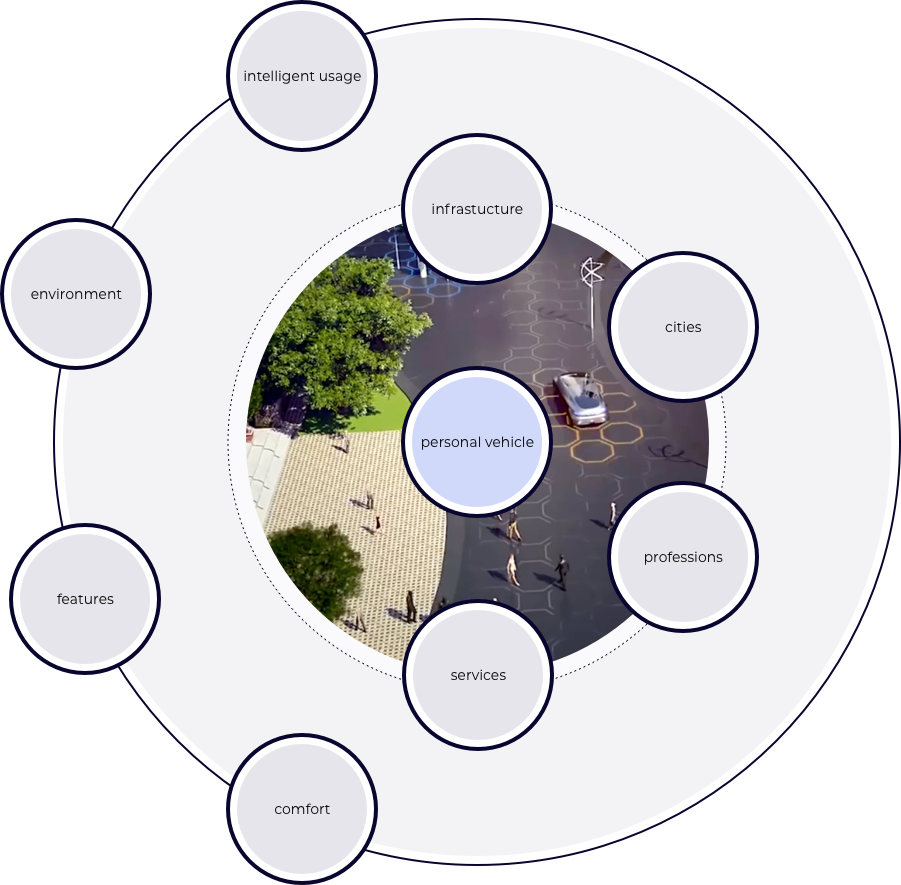
The influence of sharing economy
The influence of sharing economy
The sharing economy is characterized by a massive desire for collective consumption, as service providers such as Uber or Airbnb have demonstrated in the past few years. The networks offer people a much wider range of resource use than would normally be possible. Taking a closer look at urban areas where problems of today's mobility are concentrated, it is not surprising that people continuously give up owning a vehicle - mostly due to the massive loss of time, which cancels the usefulness of the vehicle - and increasingly use public mobility services. Autonomous driving opens up significantly more potential uses during driving time, which meets the core need of people today: More efficient use of time. Advancing technologies indicate that this offer could be represented by a fleet of autonomous vehicles in the future, a new branch of the sharing economy. This is likely, because new technologies are often very expensive when they enter the market and critical usage volumes can only be guaranteed within a service ecosystem.
The sharing economy is characterized by a massive desire for collective consumption, as service providers such as Uber or Airbnb have demonstrated in the past few years. The networks offer people a much wider range of resource use than would normally be possible. Taking a closer look at urban areas where problems of today's mobility are concentrated, it is not surprising that people continuously give up owning a vehicle - mostly due to the massive loss of time, which cancels the usefulness of the vehicle - and increasingly use public mobility services.
Autonomous driving opens up significantly more potential uses during driving time, which meets the core need of people today: More efficient use of time. Advancing technologies indicate that this offer could be represented by a fleet of autonomous vehicles in the future, a new branch of the sharing economy. This is likely, because new technologies are often very expensive when they enter the market and critical usage volumes can only be guaranteed within a service ecosystem.
The shared vehicle as a third living space
The shared vehicle as a third living space
The boundaries of the three typical living spaces - home, work and the space in between - are blurring today as never before due to todays technological developments and services. There is a constant search for new potential uses during driving time, that open up with the help of the autonomous vehicle. Currently, however, most usage scenarios are limited to personally owned vehicles. Fascinating concepts and developments for the vehicle interior or digital assistants with artificial intelligence features show how we will use the car as a third living space in the future - we will watch movies, hold meetings or simply enjoy the view of a metropolis while we put the driving itself into the hands of a machine.
The influence of ai, sharing economy and today's mobility problems meands an enormous modification for the vehicle as a third living space. On the one hand, driving time will offer new potential uses that seem unthinkable today, and on the other hand, the vehicle will lose its current individuality in such a scenario.
People will never stop moving, only the way they do it will change incessantly. Looking at current trends, a scenario in which people get around with the help of a publicly accessible autonomous fleet is conceivable. The question is: Is it possible to preserve individuality and the importance of the vehicle as a third living space in such a scenario?
The boundaries of the three typical living spaces - home, work and the space in between - are blurring today as never before due to todays technological developments and services. There is a constant search for new potential uses during driving time, that open up with the help of the autonomous vehicle. Currently, however, most usage scenarios are limited to personally owned vehicles. Fascinating concepts and developments for the vehicle interior or digital assistants with artificial intelligence features show how we will use the car as a third living space in the future - we will watch movies, hold meetings or simply enjoy the view of a metropolis while we put the driving itself into the hands of a machine.
The influence of ai, sharing economy and today's mobility problems meands an enormous modification for the vehicle as a third living space. On the one hand, driving time will offer new potential uses that seem unthinkable today, and on the other hand, the vehicle will lose its current individuality in such a scenario.
People will never stop moving, only the way they do it will change incessantly. Looking at current trends, a scenario in which people get around with the help of a publicly accessible autonomous fleet is conceivable. The question is: Is it possible to preserve individuality and the importance of the vehicle as a third living space in such a scenario?
Zero emissions, zero ownership and zero accidents are the three key paradigms driving the evolution of vehicles and mobility in general. The vehicle as we know today will be affected by this modification.
Zero emissions, zero ownership and zero accidents are the three key paradigms driving the evolution of vehicles and mobility in general. The vehicle as we know today will be affected by this modification.
#Ideation_Expectation mapping, concept mapping, storyboarding, solution sketches
#Ideation_Expectation mapping, concept mapping, storyboarding, solution sketches
Expectation map
Expectation map
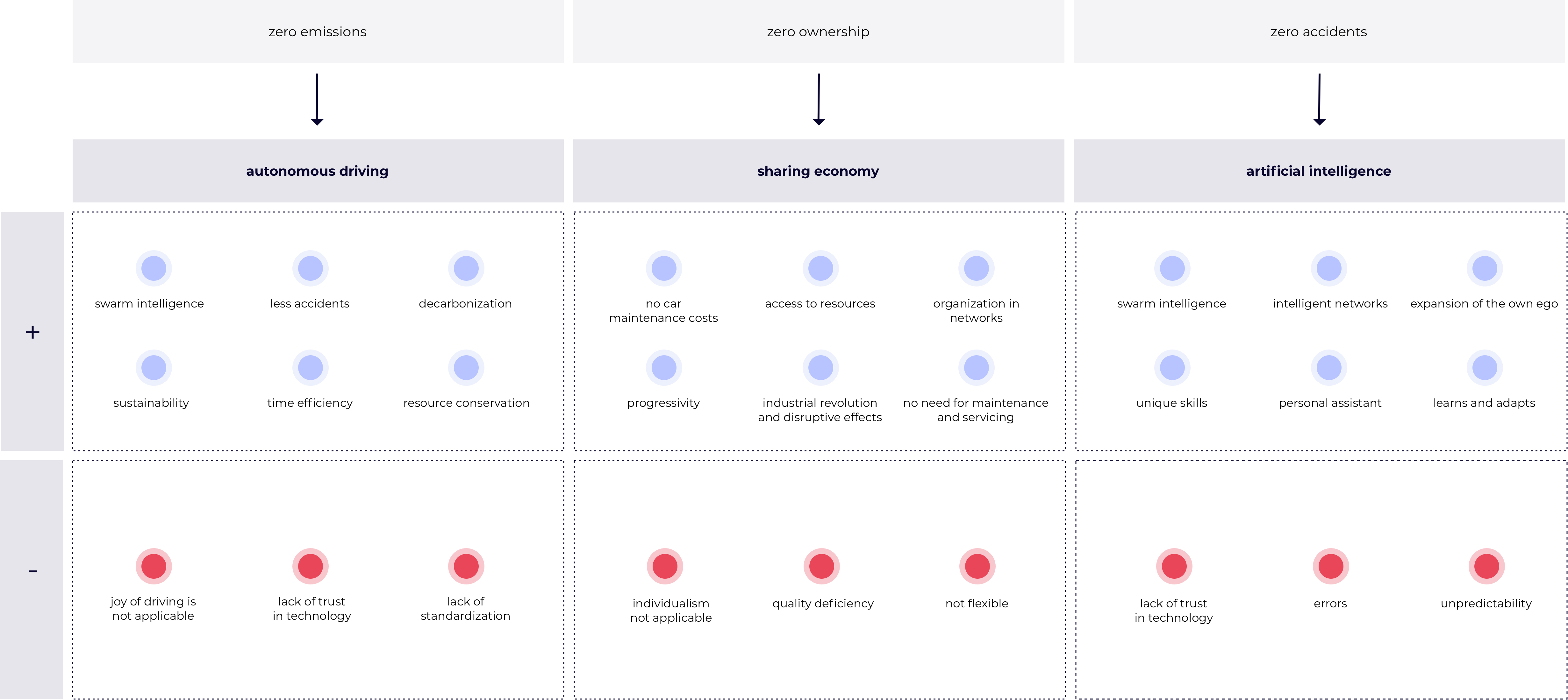
Concept map - hierarchy of service objects
Concept map - hierarchy of service objects
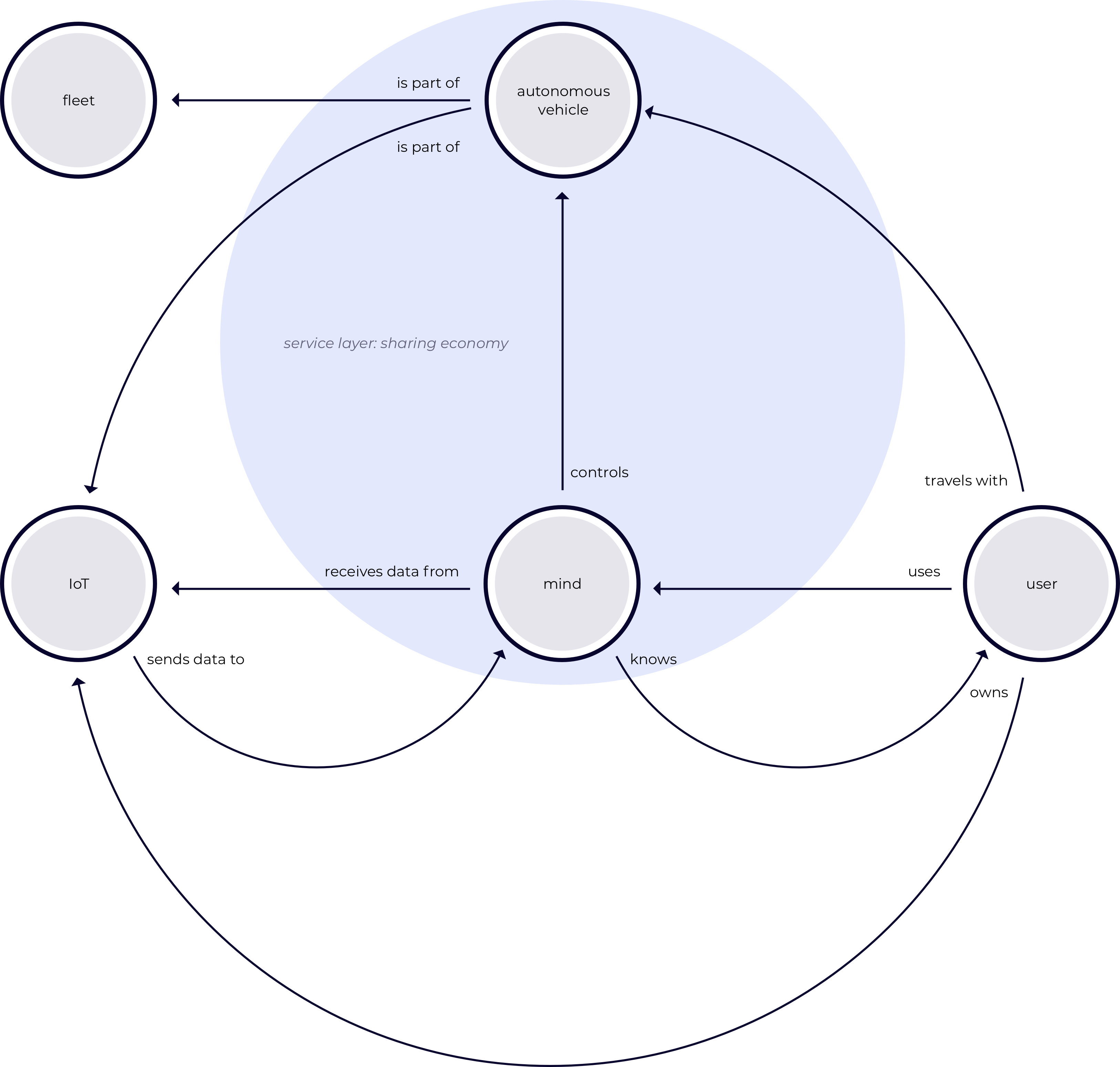
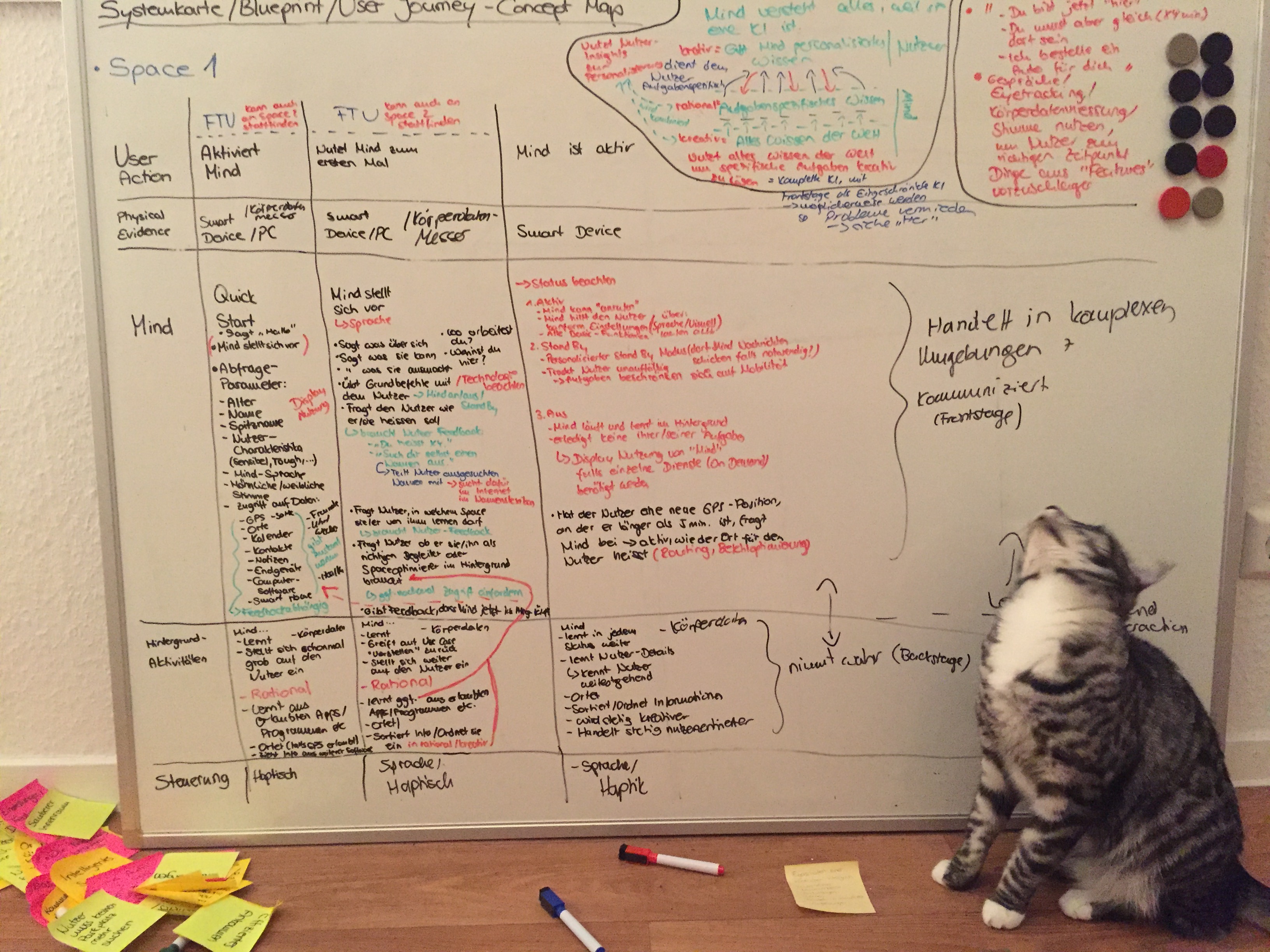

#Conception & prototyping_Customer Journey, storytelling, system blueprint, user flows, low & high fidelity prototype
#Conception & prototyping_Customer Journey, storytelling, system blueprint, user flows, low & high fidelity prototype
Prototype moods
Prototype moods
a
a
a
a
mind video
Mind video
Anything one man can imagine, other men can make real.
Anything one man can imagine, other men can make real.
JULEZ VERNE
